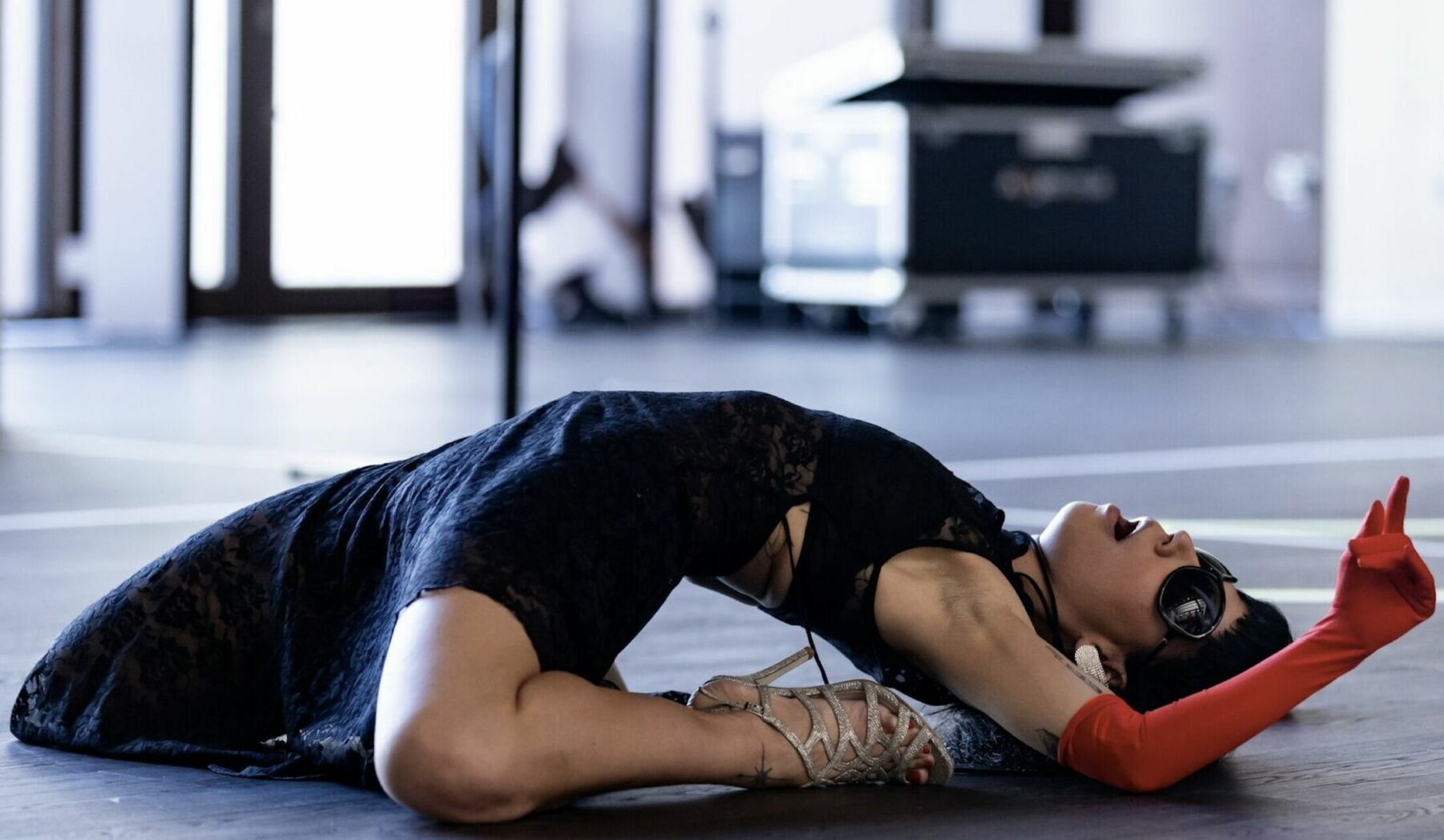Text by Ludovica Bulciolu
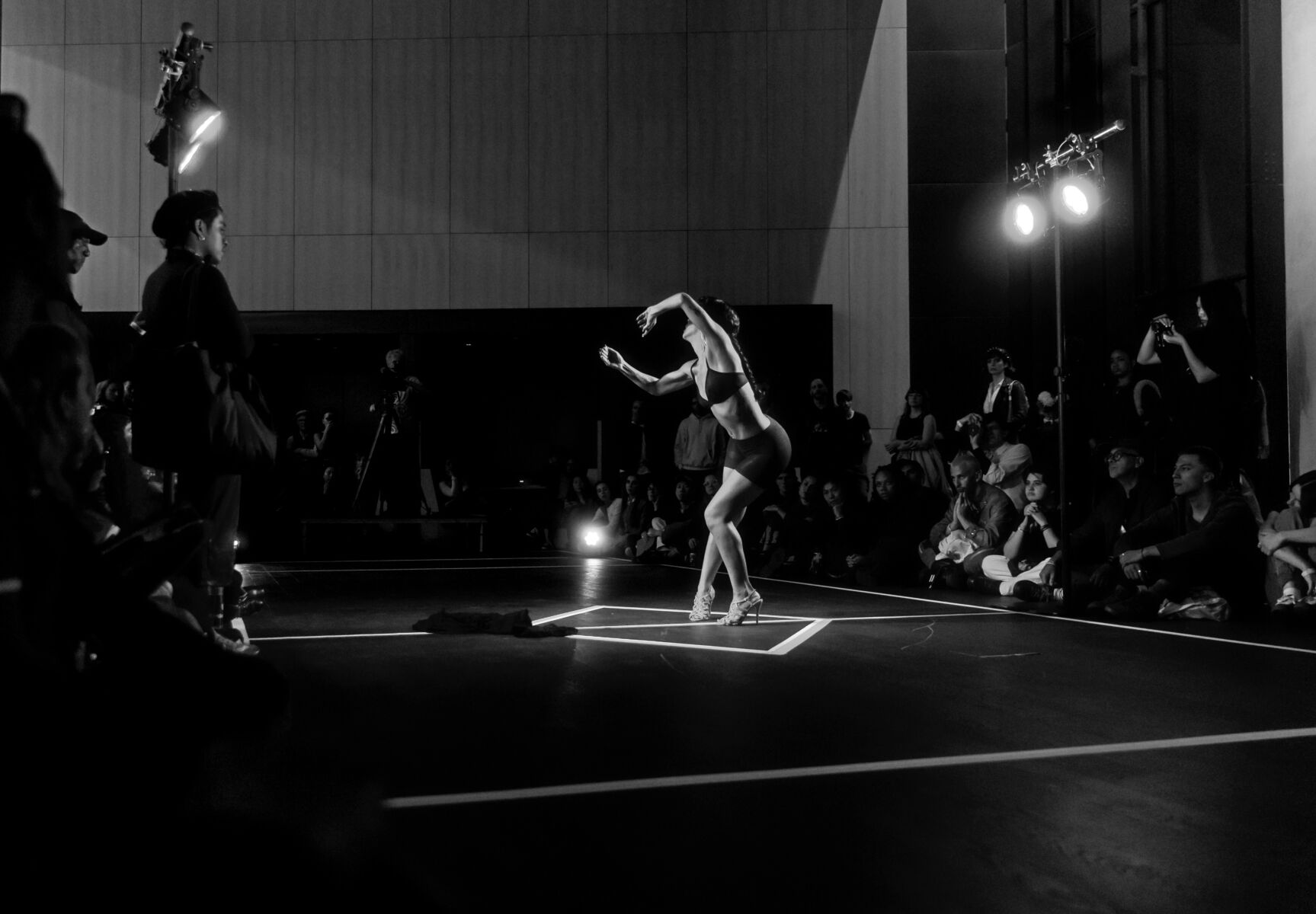
The land retreats, the water beneath her, turquoise and blue, as if an enormous sky had cried from the surrounding rocks and opened at her feet. The steps, irregular and infinitely small, make circles, half dancing, half swimming, closer and closer to each other until dissolving into an ancient darkness. Across the midst of a synth-altered microcosm of presences, broken frequencies and ritualistic chants, the kingdom of waters unfolds, and a mermaid from another time or universe appears. Eyes closed and ears trying to discern what they hear and feel, but they can’t. They are unable to distinguish a scream from a drop, from a cling, from an asteroid or a vision – just like an unknown language that has no shape but memory and miracles. It’s compelling, at times difficult to stay still, time blurs in a silent fog.
Featuring the work of Mexican multidisciplinary artist Paola Estrella investigating the symbolism and history of the cenote ring in Yucatán, Cenote Ring is a performance and site-specific installation exploring the myths and legends surrounding these natural sinkholes created by an ancient asteroid impact. The premiere debut of Estrella, in collaboration with the London-based experimental musical duo Bon Music Vision, was one of the two shows presented at Tecnobrujxs, an event curated by Diasporas Now, part of the V&A East pre-opening programme back2back’s first event InBetween: A Latinx Takeover, curated by Rubén Salgado Perez.
The performance connects the cenote’s historical and cultural significance with the contemporary challenges of the political, social, and ecological crises we are currently facing. Featuring the producers collaborating with Estrella for the very first time, the show blends their respective sensorial, visual, and sonic universes into one another.
Bon’s live sound score allows us into the glitched metaverse of a techno-shamanistic ritual, where a new world yet to come speak about old myths via sound distortions; subtly reminiscing their ongoing sonic-visual project The Industry of Emotions which is, in their words, a narrative reflecting on the sense of self and identity in the digital realm. A project that serves as a visual album of dream logic using AI, volumetric renders, digital film, projections, and FX techniques scored through the lens of Afro-Futurism, Asian Industrial electronica, Sound System music, Post Rave and Dub.
Water flows, as dissonant noises collapse into one another, and the mermaid voice of Estrella whispers softly and decisively, there are infinitely many ways of being, other ways of existing within the same reality (…); every time we try to pick something on itself we find a pinch of everything else in the universe. Set in vivid precolonial nights, or in a deep time capsule where the presence of those gone is strong and in-dismissible, – the sonic and visual invocation of a cenote ring works as a portal for mutual understanding and collective healing.
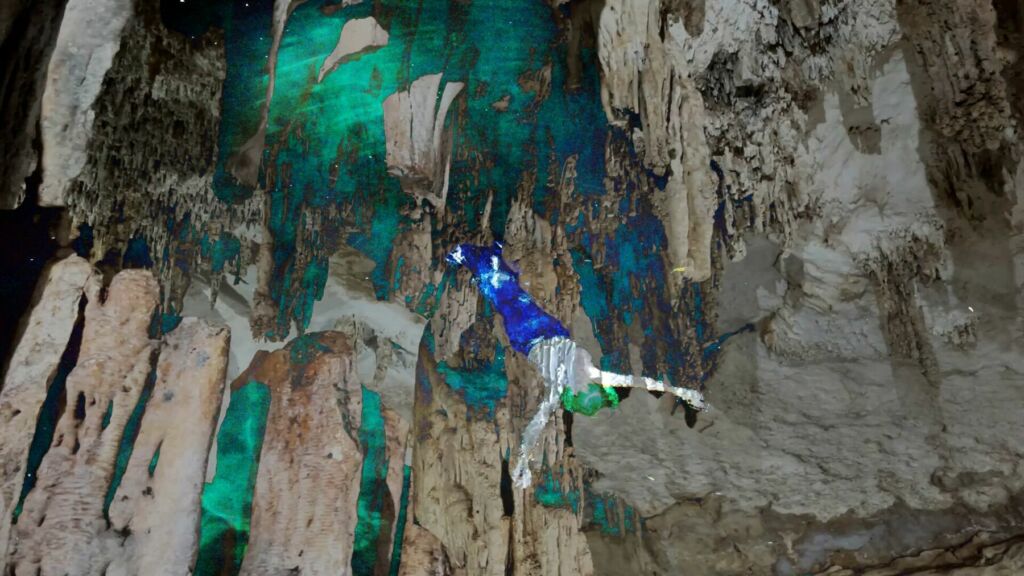
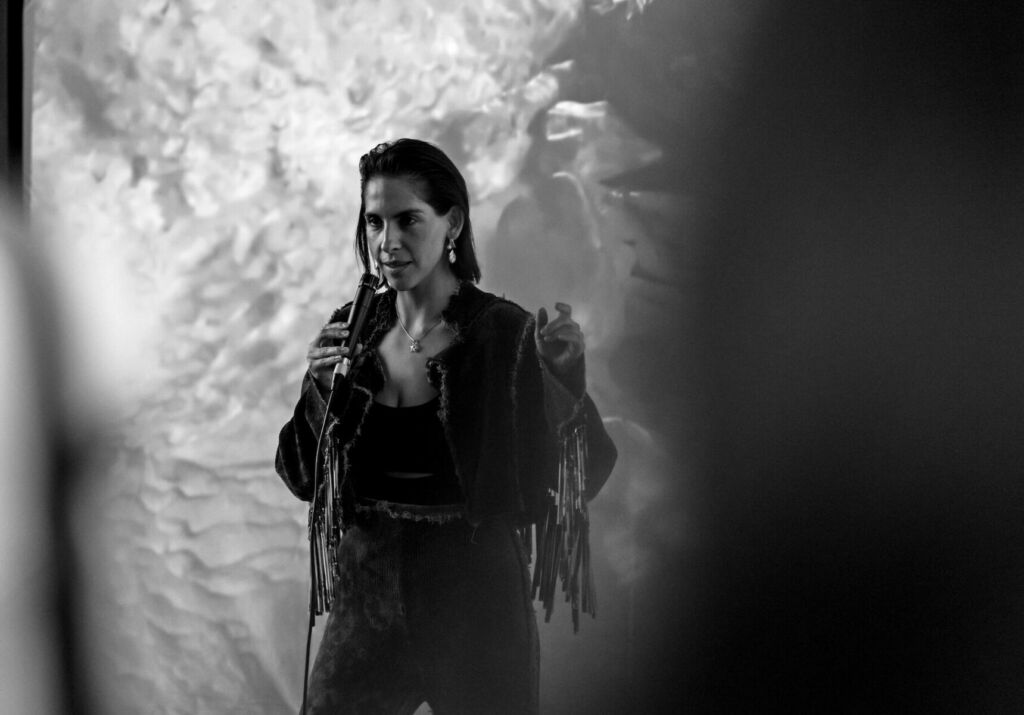
A few steps away and some instants later, a mysterious creature, half woman half machine, slides down the main staircase of UCL East’s fourth floor, entering the scene, which has suddenly turned into a dark club stage. Witch-like, snake-like, raver-like, Puerto Rican choreographer and dancer Kianí del Valle shines a dark purple light throughout the room, sharply illuminating the public’s faces, while iconically making her first appearance in the London scene for over four years. Built over the last decades, her groundbreaking performance practice crosses borders between dance, theatre, experimental choreography and electronic music while featuring some outstanding collaborations with equally visionary artists.
Behind her at the decks, British-Chilean artist and producer Kamixlo, performs a live mix of soft and hard sonics, slowly guiding the dancer into a gentle but dense and melancholic electronic. Although it’s their first collaboration, it feels like they have known each other for a very long time. Muffled with an 80’s horror film atmosphere, the movements of a body-machine are subtle yet clear references to creatures from other worlds, working as silent characters madly coexisting in one figure and revealing glimpses of their personality: gesture, by mimic, by step, by stillness. An exquisitely rich universe unfolds, oscillating between intimate and melodic gestures, aggressive hardcore tones followed by monstrous characters in an urgent tension to leave the stage to a human walking down the ballroom in raver-category.
That night we were lucky to witness the first presentation of Almas en Cadena, Del Valle’s new performance, which sees her alone on stage, this time in collaboration with Kamixlo. The project is inspired by a process she had previously explored in Templo Agrietado, an earlier piece where her body functioned as a vessel for many souls fighting each other while trying to claim her flesh before one of them prevailed over the others. In this sense, Almas en Cadena functions as an incubator reflecting on this, where the body becomes a receptacle for homing creatures, times, worlds and ancestors.
An example of this presence within the choreographer’s performance is the tribute to the horror film Cronos (1993) by acclaimed Mexican director Guillermo del Toro, alongside other cinematic, theatrical or mystic references. This intertwined web of world-building practices seems to be devoted, among other things, to weaving threads of spiritual healing practices while tracing connections between anticolonial resistance together with techno culture and popular references to sport and games. A closer look at the stage floor reveals a semi-intricate geometric pattern made out of pale coloured tape, dividing the stage into symmetric sections as if in a sports hall.
But while paying tribute to Kianí’s obsession with sports (in her own words), instead of balls rolling between players hands, a more fictional game takes place here, where the dancer, the only figure on the stage, enters into a dialogue with absent yet present characters respecting the structure of a game, the rules of which we ignore. The artist, who has a collaborative practice alongside her solo work, is the founder of the Berlin-based KDV Performance Group and brings with her on stage a game, glinting at other performers not physically present on stage.
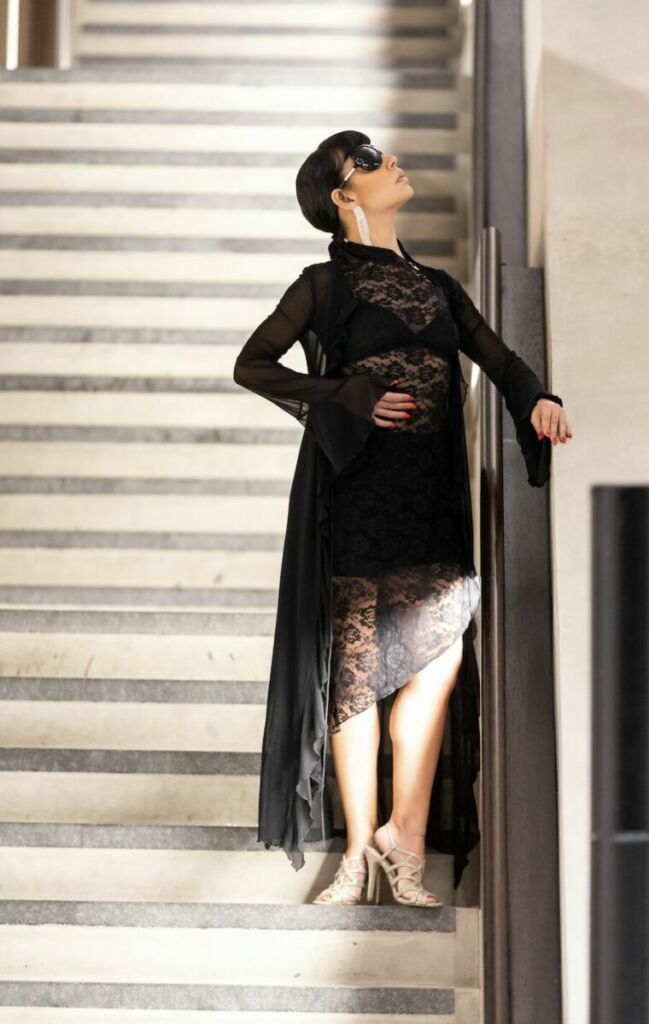
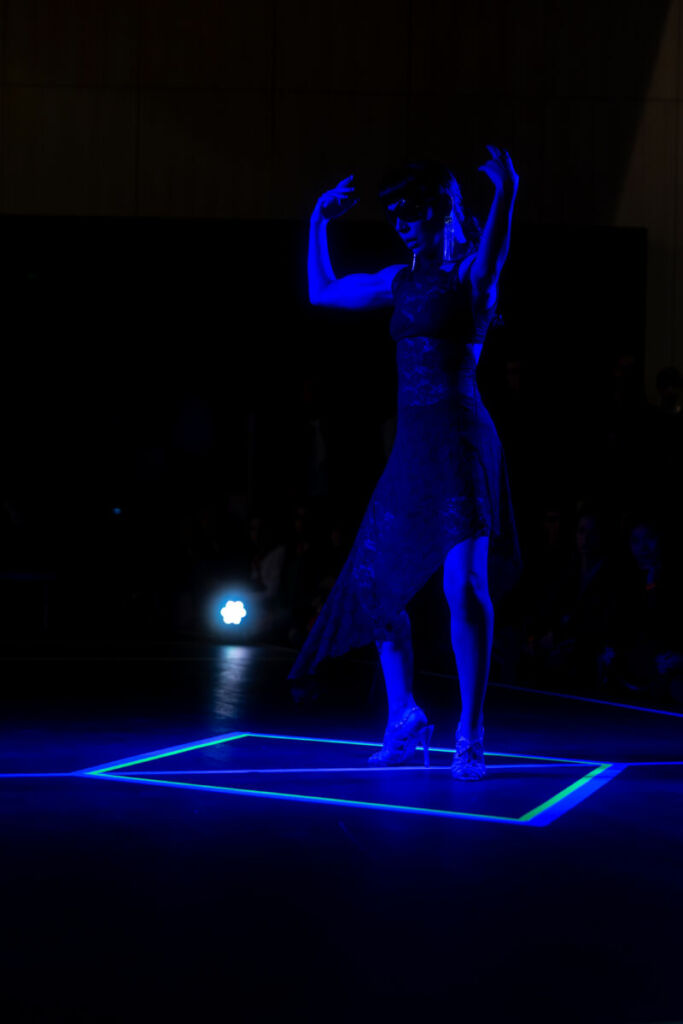
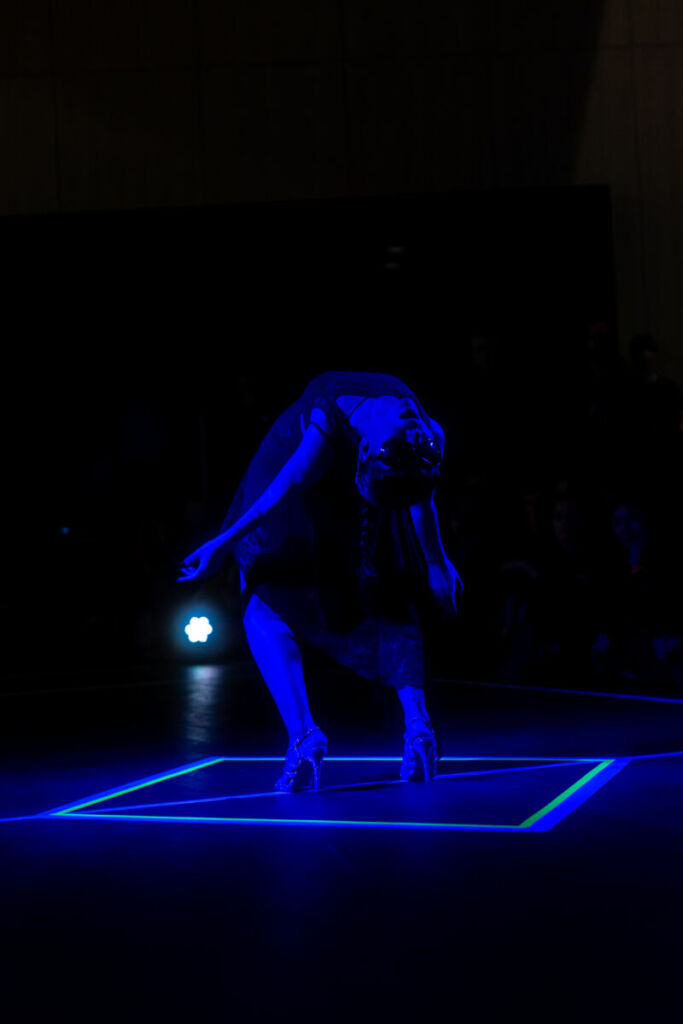
The performances are over, and a trusty crowd gathers in what is left of the club scene, following the voice of Diasporas Now’s director and Tecnobrujxs curator, Rieko Whitfield, alongside Estrella and Del Valle. We hear discussions of magic and process, memory and recording, but also about glitches, about manifesting hopes for the generation of artists to come. We hear about techno as a powerful tool in weaving threads of resistance, working as a strategy for decolonising the club culture and scene. This is exactly where the event title was born, Tecnobrujxs, a play on words by Whitfield, bringing the gender-neutral Spanish word brujx (witch) into a semantic dialogue with a leftfield club imaginary.
Working as a platform for extended performance for and by artists of the global majority celebrating cross-diasporic identities, Diasporas Now programmes curated events at the intersection of art, music and nightlife through live showcases, workshops, panel discussions, and artist development programmes in collaboration with UK’s leading art institutions [1]. As the conversation unfolds, sparkling light on the performer’s resolutions for their respective debuts and precise moments of their career, the intention of the event becomes clearer and clearer and questions around notions of institutional critique are framed, as well as propositions to more sustainable means of cultural investment.
In between decades of conversations around the decolonisation of museum collections and the failure of many projects of devolution and reparations, I wonder how cultural institutions can work towards a more profound acknowledgement of BIPOC expanded performance practices as art forms holding central roles in their programming and not only to be featured as a one-off, fleeting collaborations. How can institutions embrace the immateriality of practices such as experimental dance and live music, providing them equal support as what they give to more tangible, quantifiable, and commodifiable mediums entering their material archives?
In this context, it seems relevant to listen and learn from the experiences of artists and collectives such as Diasporas Now, who are quickly ascending and taking over the UK’s most iconic art spaces. In fact, the London-based collective is doing avant-garde work in building tools and networks that create space for those who are historically under-represented in the cultural canon, with the clear intention of changing the narrative from within. From a conversation with Rieko Whitfield emerges the urgent need for artists to conjure alternative worlds within the museum while cherishing deep relationships with the individuals that make institutions alive.
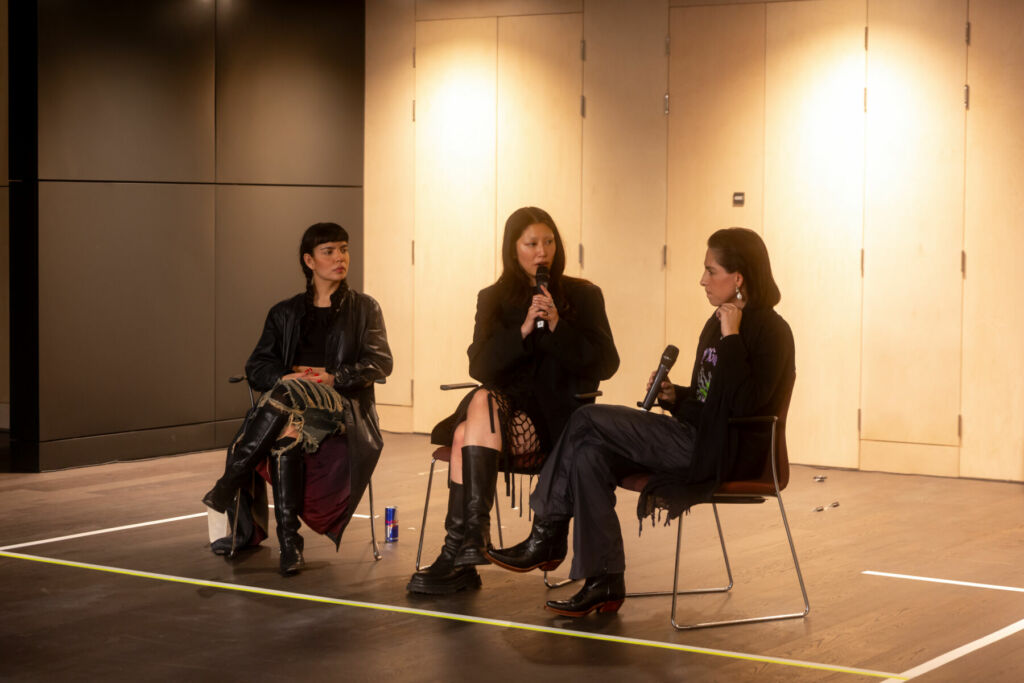
To quote her insights from our exchange: Institutional decolonisation, whether as gestures toward social justice or cultural relevance, has always felt empty to me. In my years of navigating institutions, from a purely strategic standpoint I am not interested in expending energy into the discourse of decolonisation as I am in fostering alternate narratives altogether. When museums, collections, and displays are largely Western byproducts of colonialism, how can we prototype cultural infrastructure outside of, or beyond this framework?
There are different developmental stages to social movements, and at our current stage in Western culture, we need artists to envision alternative futures now more than ever. This is why I always refer to Diasporas Now as a ‘Trojan Horse’ – we offer the infrastructure of access for artists who have historically been excluded from the cultural conversation. Especially now that decolonisation has had some time in the zeitgeist, we shouldn’t be reduced to performing in someone else’s diversity parade. We deserve seats at the table.
Diasporas Now has always prioritised long-term sustainability as a platform, and one of the key factors for our sustained growth has been through strategic partnerships. For example, Tecnobrujxs was the result of an over year-long relationship with V&A Contemporary Programme Manager and InBetween curator Rubén Salgado Perez, who invited me to perform as a solo musician last spring for a V&A Lates. We happened to meet again a year later, and Tecnobrujxs began to take shape over months of coffees, Google Docs, and WhatsApp conversations. I’m so grateful for people like Rubén, along with many radical curators I have worked with across various institutions, who are changing the system from within.
Hands shake, bodies hug, languid gazes and smiles hold each other and cross the large room, now almost empty. The threads of a deep and powerful conversation are set up just before the university has to shut its door, but our presence and interconnectedness can move worlds and spread words and awareness on the other side of the walls. The reflection is old yet still urgent, but it will keep flourishing. Beyond the screens, it lives in our hands, on our streets, and in our homes.

